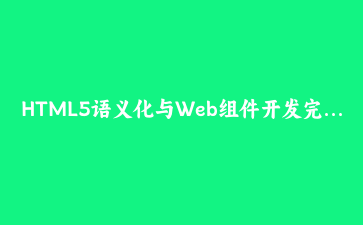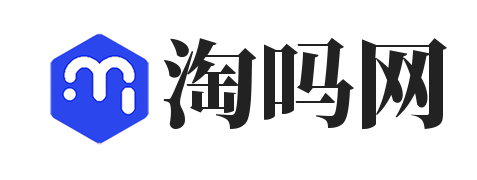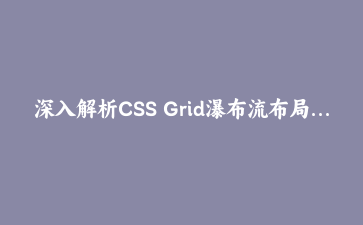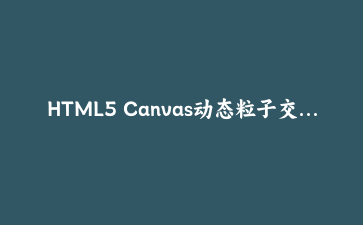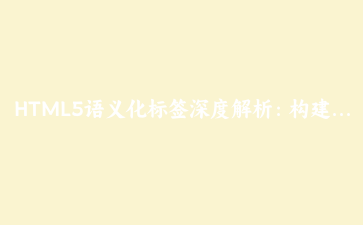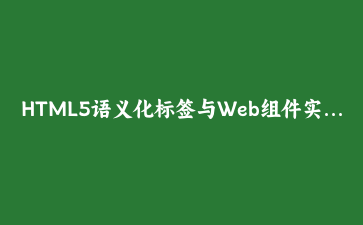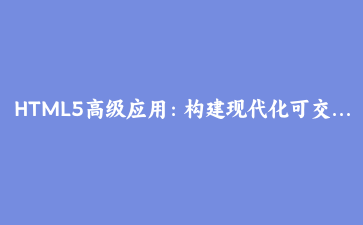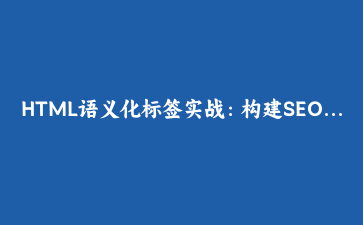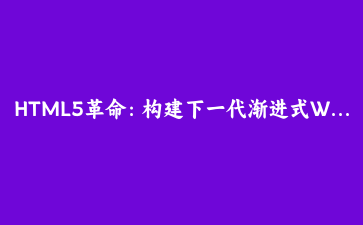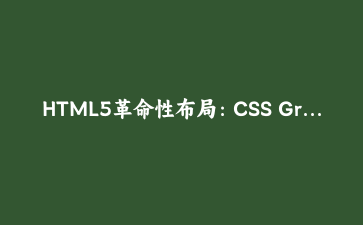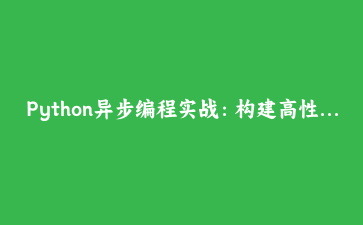探索HTML5语义化标签的威力并学习如何创建可重用的Web组件
一、HTML5语义化概述
HTML5引入了大量语义化元素,这些元素不仅使代码更易于理解和维护,还提高了网站的可访问性和SEO表现。
为什么语义化HTML很重要?
- 可访问性:屏幕阅读器和其他辅助技术能更好地理解页面结构
- SEO优化:搜索引擎更容易识别和索引内容
- 代码可维护性:清晰的文档结构使代码更易于理解和维护
- 未来兼容性:使用标准元素确保与未来浏览器和设备的兼容性
二、HTML5语义化标签详解
1. 文档结构标签
<header>
<h1>网站标题</h1>
<nav>
<ul>
<li><a href="#home" rel="external nofollow" >首页</a></li>
<li><a href="#about" rel="external nofollow" >关于</a></li>
</ul>
</nav>
</header>
<main>
<article>
<header>
<h2>文章标题</h2>
<p>发布日期:<time datetime="2023-10-15">2023年10月15日</time></p>
</header>
<section>
<h3>章节标题</h3>
<p>文章内容...</p>
</section>
</article>
<aside>
<h3>相关链接</h3>
<ul>
<li><a href="#" rel="external nofollow" >相关文章1</a></li>
</ul>
</aside>
</main>
<footer>
<p>© 2023 公司名称</p>
</footer>
2. 文本内容语义化标签
<p>这是<mark>高亮</mark>文本</p>
<figure>
<img src="image.jpg" alt="描述图片内容">
<figcaption>图片标题或描述</figcaption>
</figure>
<details>
<summary>点击查看详情</summary>
<p>这里是详细内容,默认是隐藏的</p>
</details>
<blockquote cite="https://example.com">
<p>这是引用的文本内容</p>
<footer>— 引用来源, <cite>作品名称</cite></footer>
</blockquote>
3. 表单增强元素
<form>
<fieldset>
<legend>个人信息</legend>
<label for="name">姓名:</label>
<input type="text" id="name" name="name" required>
<label for="email">邮箱:</label>
<input type="email" id="email" name="email" required>
<label for="birthdate">生日:</label>
<input type="date" id="birthdate" name="birthdate">
<label for="favcolor">喜欢的颜色:</label>
<input type="color" id="favcolor" name="favcolor">
<label for="volume">音量:</label>
<input type="range" id="volume" name="volume" min="0" max="100">
<label for="search">搜索:</label>
<input type="search" id="search" name="search">
<datalist id="browsers">
<option value="Chrome">
<option value="Firefox">
<option value="Safari">
</datalist>
<label for="browser">选择浏览器:</label>
<input list="browsers" id="browser" name="browser">
<output name="result" for="volume">50</output>
</fieldset>
<button type="submit">提交</button>
</form>
三、Web组件开发基础
Web Components是一套不同的技术,允许您创建可重用的自定义元素,它们的功能封装在代码的其余部分之外。
1. 自定义元素(Custom Elements)
// 定义一个自定义元素
class UserCard extends HTMLElement {
constructor() {
super();
// 创建Shadow DOM
this.attachShadow({ mode: 'open' });
// 定义组件模板
this.shadowRoot.innerHTML = `
<div class="user-card">
<img>
<div class="info">
<h3></h3>
<p><slot name="email"></slot></p>
<button class="btn">关注</button>
</div>
</div>
`;
}
// 定义可观察的属性
static get observedAttributes() {
return ['name', 'avatar'];
}
// 当元素被添加到DOM时调用
connectedCallback() {
this.shadowRoot.querySelector('.btn').addEventListener('click', () => {
this.toggleFollow();
});
}
// 当元素从DOM中移除时调用
disconnectedCallback() {
console.log('元素已从DOM中移除');
}
// 当属性变化时调用
attributeChangedCallback(name, oldValue, newValue) {
if (name === 'name') {
this.shadowRoot.querySelector('h3').textContent = newValue;
} else if (name === 'avatar') {
this.shadowRoot.querySelector('img').src = newValue;
}
}
// 自定义方法
toggleFollow() {
const button = this.shadowRoot.querySelector('.btn');
if (button.textContent === '关注') {
button.textContent = '已关注';
button.style.backgroundColor = '#4CAF50';
} else {
button.textContent = '关注';
button.style.backgroundColor = '#007bff';
}
}
}
// 注册自定义元素
customElements.define('user-card', UserCard);
2. 使用自定义元素
<user-card name="张三" avatar="avatar.jpg">
<span slot="email">zhangsan@example.com</span>
</user-card>
<user-card name="李四" avatar="lisi.jpg">
<span slot="email">lisi@example.com</span>
</user-card>
四、模板元素与插槽
1. 使用模板元素
<template id="product-card">
<div class="product-card">
<img src="" alt="">
<h3></h3>
<p class="price"></p>
<p class="description"></p>
<button>加入购物车</button>
</div>
</template>
<script>
// 使用模板创建元素
function createProductCard(product) {
const template = document.getElementById('product-card');
const clone = template.content.cloneNode(true);
clone.querySelector('img').src = product.image;
clone.querySelector('img').alt = product.name;
clone.querySelector('h3').textContent = product.name;
clone.querySelector('.price').textContent = `¥${product.price}`;
clone.querySelector('.description').textContent = product.description;
clone.querySelector('button').addEventListener('click', () => {
addToCart(product);
});
return clone;
}
// 添加到DOM
const products = [
{
name: '产品1',
price: 99.99,
image: 'product1.jpg',
description: '产品描述...'
}
// 更多产品...
];
const container = document.getElementById('products-container');
products.forEach(product => {
container.appendChild(createProductCard(product));
});
</script>
2. 使用插槽(Slot)
<template id="modal-template">
<div class="modal">
<div class="modal-content">
<header>
<h2><slot name="title">默认标题</slot></h2>
<span class="close">×</span>
</header>
<div class="modal-body">
<slot name="content"></slot>
</div>
<footer>
<slot name="footer">
<button class="btn-default">关闭</button>
</slot>
</footer>
</div>
</div>
</template>
<custom-modal>
<span slot="title">自定义标题</span>
<div slot="content">
<p>这是自定义内容</p>
<p>可以使用任何HTML元素</p>
</div>
<div slot="footer">
<button class="btn-primary">确认</button>
<button class="btn-default">取消</button>
</div>
</custom-modal>
五、完整案例:创建可重用的评分组件
1. 定义评分组件
class RatingStars extends HTMLElement {
constructor() {
super();
this.attachShadow({ mode: 'open' });
this.maxRating = parseInt(this.getAttribute('max')) || 5;
this.rating = parseInt(this.getAttribute('rating')) || 0;
this.readonly = this.hasAttribute('readonly');
this.shadowRoot.innerHTML = `
<div class="rating">
${this.generateStars()}
<span class="rating-text"></span>
</div>
`;
this.updateRatingText();
if (!this.readonly) {
this.addEventListeners();
}
}
generateStars() {
let starsHTML = '';
for (let i = 1; i <= this.maxRating; i++) {
const filled = i <= this.rating ? 'filled' : '';
starsHTML += `
<span class="star ${filled}" data-value="${i}">
${i {
star.addEventListener('click', () => {
this.rating = parseInt(star.getAttribute('data-value'));
this.updateRating();
this.dispatchEvent(new CustomEvent('rating-change', {
detail: { rating: this.rating }
}));
});
star.addEventListener('mouseover', () => {
if (!this.readonly) {
const value = parseInt(star.getAttribute('data-value'));
this.previewRating(value);
}
});
star.addEventListener('mouseout', () => {
if (!this.readonly) {
this.updateRating();
}
});
});
}
previewRating(value) {
const stars = this.shadowRoot.querySelectorAll('.star');
stars.forEach((star, index) => {
if (index {
if (index {
star.replaceWith(star.cloneNode(true));
});
}
rerender() {
this.shadowRoot.innerHTML = `
<div class="rating">
${this.generateStars()}
<span class="rating-text"></span>
</div>
`;
this.updateRatingText();
if (!this.readonly) {
this.addEventListeners();
}
}
}
customElements.define('rating-stars', RatingStars);
2. 使用评分组件
<rating-stars rating="3" max="5"></rating-stars>
<rating-stars rating="4" max="5" readonly></rating-stars>
<script>
// 监听评分变化
document.querySelector('rating-stars').addEventListener('rating-change', (e) => {
console.log('用户评分:', e.detail.rating);
});
</script>
六、最佳实践与性能优化
1. 语义化HTML最佳实践
- 根据内容含义选择合适的HTML元素
- 使用正确的文档结构(header, main, footer, nav等)
- 为图像提供有意义的alt文本
- 使用ARIA属性增强可访问性
- 确保表单元素有正确的label关联
2. Web组件最佳实践
- 为自定义元素添加前缀避免命名冲突(如my-app-button)
- 合理使用Shadow DOM实现样式封装
- 使用属性而不是直接操作DOM来更新组件状态
- 实现属性观察和响应式更新
- 提供清晰的API和事件系统
3. 性能优化建议
- 延迟加载非关键Web组件
- 使用模板和克隆而不是innerHTML
- 合理使用事件委托减少事件监听器数量
- 避免在频繁调用的方法中创建新元素
- 使用CSS变量实现主题化而不是内联样式
七、浏览器兼容性与渐进增强
1. 检测浏览器支持
// 检测自定义元素支持
if (typeof customElements !== 'undefined') {
// 浏览器支持自定义元素
} else {
// 提供降级方案或加载polyfill
}
// 使用特性检测
const supportsTemplates = 'content' in document.createElement('template');
const supportsShadowDOM = typeof attachShadow !== 'undefined';
2. 使用Polyfill
<!-- 加载Web Components polyfill -->
<script src="https://unpkg.com/@webcomponents/webcomponentsjs@2.6.0/webcomponents-bundle.js"></script>
<!-- 或者使用ES模块版本 -->
<script type="module">
import '@webcomponents/webcomponentsjs/webcomponents-bundle.js';
</script>
3. 渐进增强策略
- 为不支持Web Components的浏览器提供基本功能
- 使用条件加载只对支持新特性的浏览器提供增强体验
- 确保核心功能在所有浏览器中都能正常工作
- 提供适当的用户反馈和降级方案
八、总结
HTML5语义化和Web Components技术为现代前端开发提供了强大的工具和方法。通过合理使用这些技术,开发者可以:
- 创建更清晰、更易于维护的代码结构
- 提高网站的可访问性和SEO表现
- 构建可重用、可组合的UI组件
- 实现更好的样式封装和组件隔离
- 提高开发效率和团队协作能力
虽然Web Components在某些场景下可能不如现代前端框架功能丰富,但它们提供了浏览器原生支持的组件化解决方案,具有很好的性能和兼容性前景。
建议在实际项目中逐步尝试和应用这些技术,从简单的组件开始,逐步构建更复杂的应用架构。


